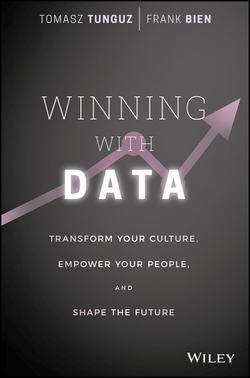Читать книгу Winning with Data - Bien Frank - Страница 6
На сайте Литреса книга снята с продажи.
Chapter 1
Mad Men to Math Men: The Power of the Data-Driven Culture
The Era of Instant Data: You Better Get Yourself Together
ОглавлениеInstant Karma's gonna get you
Gonna knock you right on the head
You better get yourself together
Pretty soon you're gonna be dead
– John Lennon
The demand for instant data will increase inexorably. Like Uber drivers seeking a passenger at this very moment, we expect answers instantly. If you're making Baked Alaska for company tonight, and you've forgotten the ratio of sugar to egg whites in the meringue that houses the ice cream, your phone will answer the question in just a few seconds.
Where is Priceline stock trading? Where do the San Francisco Giants stand in this year's pennant race? When hiring a litigation attorney, what are the key questions to ask? Are there any grammatically sound sentences in English where every word starts with the same letter?
All of these questions are instantly answerable. These are the types of questions we ask at the dinner table or when sharing a drink with a friend at a bar, and answer in a few seconds with a search query on a phone.
Because of this new instant access to just about every kind of information, we expect the same instantaneity of answers at work. Why did our sales team outperform last quarter? Which of my clients are paying the most? Does this marketing campaign acquire customers more efficiently than the others? Should we launch our product in Japan in December?
In most companies, these questions require days or weeks to answer. Consequently, data is a historical tool, a useful rearview mirror to the well-managed business. It's a lens through which we can understand what happened in the past. And, if we're lucky, it can help us understand a little bit about why the past unfolded in a particular way.
But this level of analysis pales in comparison with the practices of best-in-class companies that operationalize their data. These are businesses that use the morning's purchasing data to inform which merchandise sits on the shelves in the afternoon.
What have those companies done to access instant data? First, they've changed the way they manage themselves, their teams, and their companies; they've changed how they run meetings, how they make decisions, and how they collaborate. Employees are data literate: They understand how to access the data they need, how to analyze it, and how to communicate it well.
Second, these companies have developed functional data supply chains that send insight to the people who need it. A data supply chain comprises all the people, software, and processes related to data as it's generated, stored, and accessed. While most of us think of data as the figures in an Excel spreadsheet or a beautiful bar chart, these simple formats often hide the complexity required to produce them.
The simple Excel spreadsheet hides a churning sea of data, coursing through the company's databases, that must be synthesized and harmonized to create a single, accurate view of the truth. A data infrastructure that permits easy, instant access to answers to business questions by anyone in the company is the second step.
Third, these businesses create a data dictionary, a common language of metrics used by the company. When sales and marketing refer to a lead, the definition of a lead must be consistent across both teams. Often, different teams within a company define metrics in unique ways. Though convenient for the individual team, this approach creates confusion, inconsistency, and consternation. Robust data pipelines ensure a universal language across the company.
This combination of bottoms-up data literacy, top-down data infrastructure, and a single metrics lexicon has transformed many businesses. Google was one of the first to empower its employees with unfettered access to critical business data. Consequently, Google employees were able to leverage the company's enormous reach and resources to develop breakthrough products.
That innovation in the early 2000s cascaded through many other large and small companies, including Facebook, LinkedIn, Zendesk, and others. Above all, these companies architected data supply chains that enable their employees to extract the insights they needed to advance the company's causes. Unfortunately, most businesses still operate with outdated supply chains buckling under the strain of data demand. You better get your data together, or pretty soon you're gonna be dead.
